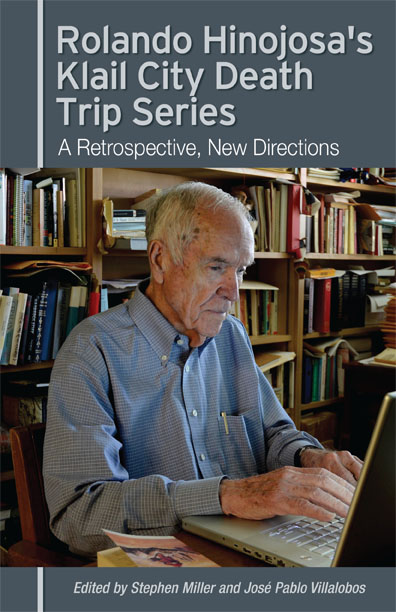Rolando Hinojosa’s Klail City Death Trip Series: A Retrospective, New Directions
$23.95
edited by Stephen Miller & Jose Villalobos
Scholars examine Rolando Hinojosa’s Klail City Death Trip Series about life in a fictional town along the Texas-Mexico border
ISBN: 978-1-55885-767-4
Category: New Titles, Non-Fiction/Reference
Published: May 31, 2013
Bind: Trade Paperback
Pages: 304
Available
Mirroring the linguistic and cultural evolution of those living on the Texas-Mexico border, Rolando Hinojosa’s Klail City Death Trip Series examines relations between Mexican-Americans and Anglo-Americans born and raised in the fictional Rio Grande Valley town of Klail City, Texas. Depicting the transformation of a place and its people “from a sleepy agricultural and ranching backwater of Mexican and American society and history” over a 30-year period, the series comprises fifteen books—published between 1973 and 2006—and reflects the importance of the growing Hispanic population in the U.S.
The people of Hinojosa’s Klail City, which has been compared to William Faulkner’s Yoknapatawpha County and Gabriel García Márquez’s Macondo, have dealt with the same issues as their real-life counterparts living along the border, including discrimination, generational change, drug violence and the quest for women’s rights. The editors of this scholarly volume assert in their introduction that the series, with volumes in English, Spanish and a mix of both languages, “may well be the most innovative and complex project of literary creation ever conceived and realized by a writer based in the United States.”
The eleven essays in this volume consider both broad and specialized aspects of the Klail City Death Trip Series. Divided into two sections, the chapters in the first half examine the series as a whole and look at general topics such as cultural hybridity, the individual’s needs versus those of society and the influence of Hispanic literary tradition on Hinojosa’s work. The essays in the second half explore more specific aspects, including Klail City youth going to war, women’s search for autonomy in the face of societal and familial tradition and a comparison of Hinojosa’s The Valley with Larry McMurtry’s The Last Picture Show as examples of Hispanic and Anglo literary traditions that developed in the same region.
Also included is an interview with Rolando Hinojosa, the Ellen Clayton Garwood Professor of Creative Writing at the University of Texas at Austin. He is the recipient of numerous literary awards, including the most prestigious prize in Latin American fiction, Casa de las Américas, for the best Spanish American novel in 1976 and the Premio Quinto Sol, the National Award for Chicano Literature, in 1972. This collection is an essential tool for scholars and students alike in understanding the work of Rolando Hinojosa and the people living a bilingual, bicultural life along the Texas-Mexico border.









